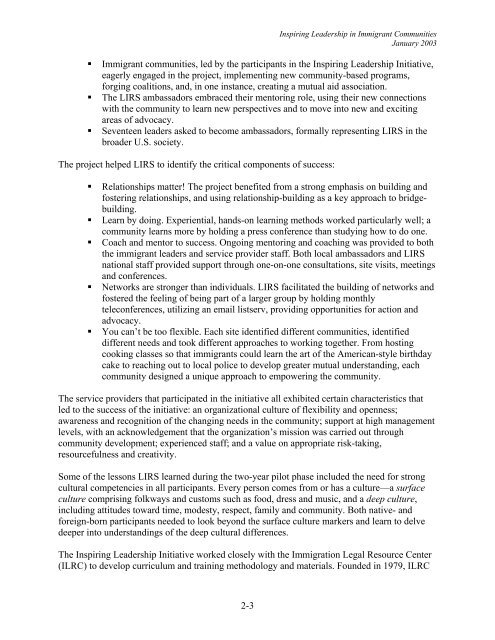Inspiring Leadership in Immigrant Communities - ILRC
Inspiring Leadership in Immigrant Communities - ILRC
Inspiring Leadership in Immigrant Communities - ILRC
- No tags were found...
Create successful ePaper yourself
Turn your PDF publications into a flip-book with our unique Google optimized e-Paper software.
<strong>Inspir<strong>in</strong>g</strong> <strong>Leadership</strong> <strong>in</strong> <strong>Immigrant</strong> <strong>Communities</strong>January 2003• <strong>Immigrant</strong> communities, led by the participants <strong>in</strong> the <strong>Inspir<strong>in</strong>g</strong> <strong>Leadership</strong> Initiative,eagerly engaged <strong>in</strong> the project, implement<strong>in</strong>g new community-based programs,forg<strong>in</strong>g coalitions, and, <strong>in</strong> one <strong>in</strong>stance, creat<strong>in</strong>g a mutual aid association.• The LIRS ambassadors embraced their mentor<strong>in</strong>g role, us<strong>in</strong>g their new connectionswith the community to learn new perspectives and to move <strong>in</strong>to new and excit<strong>in</strong>gareas of advocacy.• Seventeen leaders asked to become ambassadors, formally represent<strong>in</strong>g LIRS <strong>in</strong> thebroader U.S. society.The project helped LIRS to identify the critical components of success:• Relationships matter! The project benefited from a strong emphasis on build<strong>in</strong>g andfoster<strong>in</strong>g relationships, and us<strong>in</strong>g relationship-build<strong>in</strong>g as a key approach to bridgebuild<strong>in</strong>g.• Learn by do<strong>in</strong>g. Experiential, hands-on learn<strong>in</strong>g methods worked particularly well; acommunity learns more by hold<strong>in</strong>g a press conference than study<strong>in</strong>g how to do one.• Coach and mentor to success. Ongo<strong>in</strong>g mentor<strong>in</strong>g and coach<strong>in</strong>g was provided to boththe immigrant leaders and service provider staff. Both local ambassadors and LIRSnational staff provided support through one-on-one consultations, site visits, meet<strong>in</strong>gsand conferences.• Networks are stronger than <strong>in</strong>dividuals. LIRS facilitated the build<strong>in</strong>g of networks andfostered the feel<strong>in</strong>g of be<strong>in</strong>g part of a larger group by hold<strong>in</strong>g monthlyteleconferences, utiliz<strong>in</strong>g an email listserv, provid<strong>in</strong>g opportunities for action andadvocacy.• You can’t be too flexible. Each site identified different communities, identifieddifferent needs and took different approaches to work<strong>in</strong>g together. From host<strong>in</strong>gcook<strong>in</strong>g classes so that immigrants could learn the art of the American-style birthdaycake to reach<strong>in</strong>g out to local police to develop greater mutual understand<strong>in</strong>g, eachcommunity designed a unique approach to empower<strong>in</strong>g the community.The service providers that participated <strong>in</strong> the <strong>in</strong>itiative all exhibited certa<strong>in</strong> characteristics thatled to the success of the <strong>in</strong>itiative: an organizational culture of flexibility and openness;awareness and recognition of the chang<strong>in</strong>g needs <strong>in</strong> the community; support at high managementlevels, with an acknowledgement that the organization’s mission was carried out throughcommunity development; experienced staff; and a value on appropriate risk-tak<strong>in</strong>g,resourcefulness and creativity.Some of the lessons LIRS learned dur<strong>in</strong>g the two-year pilot phase <strong>in</strong>cluded the need for strongcultural competencies <strong>in</strong> all participants. Every person comes from or has a culture—a surfaceculture compris<strong>in</strong>g folkways and customs such as food, dress and music, and a deep culture,<strong>in</strong>clud<strong>in</strong>g attitudes toward time, modesty, respect, family and community. Both native- andforeign-born participants needed to look beyond the surface culture markers and learn to delvedeeper <strong>in</strong>to understand<strong>in</strong>gs of the deep cultural differences.The <strong>Inspir<strong>in</strong>g</strong> <strong>Leadership</strong> Initiative worked closely with the Immigration Legal Resource Center(<strong>ILRC</strong>) to develop curriculum and tra<strong>in</strong><strong>in</strong>g methodology and materials. Founded <strong>in</strong> 1979, <strong>ILRC</strong>2-3
















